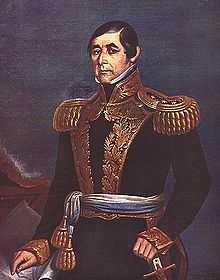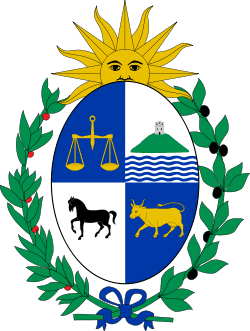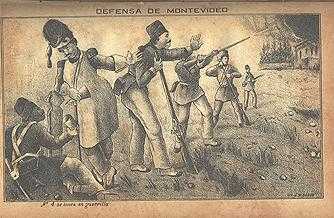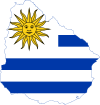Uruguayan Civil War
| ||||||||||||||||||||
| ||||||||||||||||||||
The Uruguayan Civil War, also known in Spanish as the Guerra Grande ("Great War"), was a series of armed conflicts that took place between the Colorado Party and the National Party in Uruguay from 1839 to 1851. The two parties received backing from foreign sources including both neighbouring countries such as the Empire of Brazil and the Argentine Confederation as well as imperial powers, primarily the British Empire and the Kingdom of France, but also a legion of Italian volunteers including Giuseppe Garibaldi. The nine-year Great Siege of Montevideo captured the imagination of European writers (such as Alexandre Dumas, who wrote The New Troy).
Background

The political scene in Uruguay during the 1830s became split between two parties, the conservative Blancos ("Whites") and the liberal Colorados ("Reds"). The Colorados were led by Fructuoso Rivera and represented the business interests of Montevideo; the Blancos were headed by Manuel Oribe, who looked after the agricultural interests of the countryside and promoted protectionism. The two groups took their names from the color of the armbands that they wore; initially, the Colorados wore blue, but when it faded in the sun, they replaced it with red.
Origin of the War

In 1838, France started a naval blockade over the port of Buenos Aires, supporting their allies in the Peru–Bolivian Confederation, who were involved in the War of the Confederation after Argentina and Chile declared war on them. Unable to deploy land troops, France sought allied forces to fight Juan Manuel de Rosas on their behalf. For this purpose they helped Fructuoso Rivera to topple the Uruguayan president Manuel Oribe, who was staying in good terms with Rosas.[1] Oribe was exiled to Buenos Aires and Rivera assumed power in October 1838. Rosas did not recognize Rivera as a legitimate president, and sought to restore Oribe in power. Rivera and Juan Lavalle prepared troops to attack Buenos Aires. Both British and French troops intervened, transforming the conflict into an international war.[2]
On December 6, 1842, the Blancos under Manuel Oribe and the Colorados under Fructuoso Rivera fought the Battle of Arroyo Grande. Rivera's forces were utterly defeated, and Oribe proceeded to lay siege to Montevideo.[3]
The Great Siege of Montevideo
With the destruction of the Uruguayan army at the battle of Arroyo Grande, it was assumed that the country's capital, Montevideo, would fall to the combined forces of the Buenos Aires governor Juan Manuel de Rosas and the former Uruguayan president Manuel Oribe.[4] Oribe's siege of Montevideo, Uruguay's capital, lasted for nine years.[2] The Great Siege of Montevideo meant an unusual situation, with two parallel governments:
- Gobierno de la Defensa in Montevideo, led by Joaquín Suárez (1843–1852)
- Gobierno del Cerrito (with headquarters at the present neighbourhood Cerrito de la Victoria), ruling the rest of the country, led by Manuel Oribe (1843–1851)
The newly freed slaves, who formed a contingent 5,000 strong, and the community of foreign exiles were mostly responsible for the defense of the city.[4] The British Empire eventually saved the city by allowing it to receive supplies. First, the British and French naval forces temporarily blockaded the port of Buenos Aires during the December of 1845. Then, the French and British fleets protected Montevideo from the sea. French, Spanish [5] and Italian legionnaires, led by Giuseppe Garibaldi, teamed up with the Colorados in defending the city. Historians believe that the French and British forces intervened in the region to ensure free navigation along the Rio Parana and Rio Uruguay. However, in 1850, both the French and British withdrew after signing a treaty which represented a triumph for Juan Manuel de Rosas and his Federal Party in Argentina.[2]

After the withdrawal of British and French troops, it appeared that Montevideo would fall to Juan Manuel de Rosas and former president Oribe. However, an uprising against de Rosas led by fellow Federalist Justo José de Urquiza, governor of Argentina's Entre Ríos Province, with the assistance of a small Uruguayan force, changed the situation. Manuel Oribe was defeated in 1851, leaving the Colorados in full control of the country. Brazil followed up by intervening in Uruguay in May 1851, supporting the Colorados with financial and naval forces. This led to the Platine War with Rosas in August 1851. In February 1852, after being defeated at Caseros, Rosas resigned and Urquiza's pro-Colorado forces lifted the siege of Montevideo.[2]
Consequences of the war
The government of Montevideo rewarded Brazil's financial and military support by signing five treaties in 1851 that provided for perpetual alliance between the two countries. Montevideo confirmed Brazil's right to intervene in Uruguay's internal affairs.
Brazil was required to extradite runaway slaves and criminals from Uruguay. In fact, during the war, both the Blancos and the Colorados had abolished slavery in Uruguay in order to mobilize the former slaves to reinforce their respective military forces.
The treaties also allowed joint navigation on the Rio Uruguay and its tributaries, and tax exempted cattle and salted meat exports. The Uruguayan cattle industry was devastated by the war. The treaty also acknowledged Uruguay's debt to Brazil for its aid against the Blancos, and Brazil's commitment for granting an additional loan.
Uruguay renounced its territorial claims north of the Río Cuareim, thereby reducing its area to about 176,000 square kilometers, and recognized Brazil's exclusive right of navigation in the Laguna Merin and the Rio Yaguaron, the natural border between the countries.[2]
Later conflicts
Part of a series on the |
|---|
| History of Uruguay |
 |
|
Early History
|
|
Independent State |
|
20th Century
|
|
Military Regime |
|
Modern Uruguay
|
| Uruguay portal |
Both parties were weary of the chaos. In 1870, they came to an agreement to define spheres of influence: the Colorados would control Montevideo and the coastal region, the Blancos would rule the hinterland with its agricultural estates. In addition, the Blancos were paid half a million dollars to compensate them for the loss of their stake in Montevideo. But the caudillo mentality was difficult to erase from Uruguay and political feuding continued culminating in the Revolution of the Lances (Revolución de las Lanzas) (1870–1872), and later with the uprising of Aparicio Saravia.
In popular culture
The French author Alexandre Dumas described Oribe's siege of Montevideo as a new Trojan war.[2] This comparison was made in the novel The new Troy.
Battles and sieges
- Battle of Arroyo Grande - December 6, 1842
- Siege of Montevideo - 1843
- Siege of Montevideo - 1851
See also
References
- ↑ Garibaldi in Uruguay: A Reputation Reconsidered.
- ↑ 2.0 2.1 2.2 2.3 2.4 2.5 The Great War, 1843–52.
- ↑ George Bruce, Harbottle's Dictionary of Battles. Van Nostrand Reinhold, 1981. ISBN 0-442-22336-6.
- ↑ 4.0 4.1 "The Anthony P. Campanella Collection of Giuseppe Garibaldi".
- ↑ Garibaldi in Uruguay: A Reputation Reconsidered David McLean, The English Historical Review, Vol. 113, No. 451 (April , 1998), pp. 351-366 Published by: Oxford University Press
External links
| Wikimedia Commons has media related to Uruguayan Civil War. |
| ||||||||||||||||||||||||

